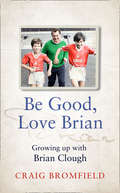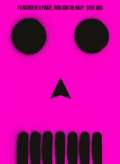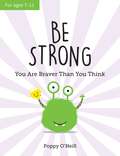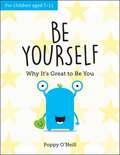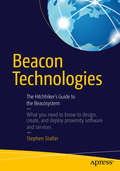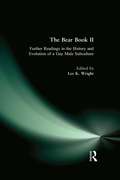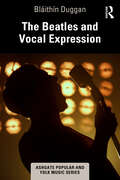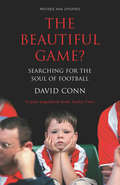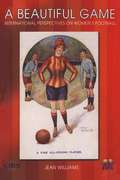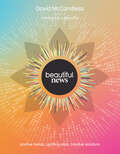- Table View
- List View
Be Good, Love Brian: Growing Up With Brian Clough
by Craig BromfieldCraig Bromfield was just 13 years old when Brian Clough, on a whim, took him and his older brother Aaron in. They came from Southwick, a depressed area of Sunderland, where they lived with their abusive stepfather, and from where they longed to escape. After initially meeting Clough while out begging for money, Clough later invited the brothers to stay at his house. From there a relationship formed which would see Craig living with the Cloughs for nine years, where he was a first-hand witness to the many aspects of Clough’s character – his gruffness, his humour, his big-heartedness. This is a beautiful, inspirational story, which has never before been told, about Clough’s gentleness and capacity for generosity. Discover a very different side to this iconic man, one away from the cameras and the football, which shows him for the person he really was.
Be More Pirate: Or How to Take On the World and Win
by Sam Conniff AllendeFT BUSINESS BOOK OF THE MONTH - MAY'Ask forgiveness, not permission! A unique approach...reminds me of the fun we've had with our airlines' - Sir Richard Branson'I'd rather be a pirate than join the navy' Steve Jobs 'Totally compelling' Ed Miliband, Reasons to be Cheerful podcast 'A model for how to break the system and create radical change' Joy Lo Dico, Evening Standard 'Be More Pirate feels so important as it looks to history to help us grip the future' Martha Lane Fox CBE, Founder of Lastminute.com 'This isn't a book, it's the beginning of a movement. Be More Pirate should come with a health warning' Tom Goodwin, author of Digital Darwinism 'A refreshing, entertaining and inspiring perspective on work, leadership and why we do what we do' Bruce Daisley, VP, Twitter 'A controversial call to arms, this contrarianism is exactly what we need to course correct 'the corporation'' Arlo Brady, CEO of Freud Communications-----Pirates didn't just break the rules, they rewrote them. They didn't just reject society, they reinvented it. Pirates didn't just challenge the status-quo, they changed everyfuckingthing. Pirates faced a self-interested establishment, a broken system, industrial scale disruption and an uncertain future. Sound familiar?Pirates stood for MISCHIEF, PURPOSE and POWER. And you can too. In Be More Pirate, Sam Conniff Allende unveils the innovative strategies of Golden Age pirates, drawing parallels between the tactics and teachings of legends like Henry Morgan and Blackbeard with modern rebels, like Elon Musk, Malala and Banksy. Featuring takeaway sections and a guide to build you own pirate code 2.0, Be More Pirate will show you how to leave your mark on the 21st century. Whatever your ambitions, ideas and challenges, Be More Pirate will revolutionize the way you live, think and work today, and tomorrow. So what are you waiting for? Order now and join the rebellion. -----Sam Conniff Allende is the founder and former CEO of Livity, a multi-award-winning youth marketing agency. Sam has led the unlikeliest collaborations between brands and bright young people on the edges of society, resulting in real innovation. He has worked with Google, Unilever, PlayStation and Dyson, and regularly speaks and runs Be More Pirate workshops at these industry-leading companies. Sam believes in the power of professional rule-breaking and is on a mission to instigate modern mutinies in organisations around the world, where the teams takeover the running of the ship to ultimately become more accountable, motivated and rebellious.
Be Strong: You Are Braver Than You Think: A Child's Guide to Boosting Self-Confidence
by Poppy O'NeillThis practical guide for children aged 7–11 combines proven cognitive behavioural therapy methods and fun and engaging activities, which are interspersed with useful tips, inspirational statements and practical information for parents, to help your child improve their self-confidence.
Be Very Afraid: The Cultural Response to Terror, Pandemics, Environmental Devastation, Nuclear Annihilation, and Other Threats
by Robert WuthnowRobert Wuthnow has been praised as one of "the country's best social scientists" by columnist David Brooks, who hails his writing as "tremendously valuable." The New York Times calls him "temperate, balanced, compassionate," adding, "one can't but admire Mr. Wuthnow's views." A leading authority on religion, he now addresses one of the most profound subjects: the end of the world. In Be Very Afraid, Wuthnow examines the human response to existential threats--once a matter for theology, but now looming before us in multiple forms. Nuclear weapons, pandemics, global warming: each threatens to destroy the planet, or at least to annihilate our species. Freud, he notes, famously taught that the standard psychological response to an overwhelming danger is denial. In fact, Wuthnow writes, the opposite is true: we seek ways of positively meeting the threat, of doing something--anything--even if it's wasteful and time-consuming. The atomic era that began with the bombing of Hiroshima sparked a flurry of activity, ranging from duck-and-cover drills, basement bomb shelters, and marches for a nuclear freeze. All were arguably ineffectual, yet each sprang from an innate desire to take action. It would be one thing if our responses were merely pointless, Wuthnow observes, but they can actually be harmful. Both the public and policymakers tend to model reactions to grave threats on how we met previous ones. The response to the terrorist attacks of 9/11, for example, echoed the Cold War--citizens went out to buy duct tape, mimicking 1950s-era civil defense measures, and the administration launched two costly conflicts overseas. Offering insight into our responses to everything from An Inconvenient Truth to the bird and swine flu epidemics, Robert Wuthnow provides a profound new understanding of the human reaction to existential vulnerability.
Be Yourself: Why It's Great to Be You: A Child's Guide to Embracing Individuality
by Poppy O'NeillThis practical guide for children aged 7–11 combines proven cognitive behavioural therapy methods and fun and engaging activities, which are interspersed with useful tips, inspirational statements and practical information for parents, to help your child build on their self-belief.
Beacon Technologies: The Hitchhiker's Guide to the Beacosystem
by Stephen StatlerLearn the key standards—iBeacon, Eddystone, Bluetooth 4.0, and AltBeacon—and how they work with other proximity technologies. Then build your understanding of the proximity framework and how to identify and deploy the best solutions for your own business, institutional, or consulting needs.Proximity technology—in particular, Bluetooth beacons—is a major source of business opportunity, and this book provides everything you need to know to architect a solution to capitalize on that opportunity.What You'll LearnUnderstand the disruptive implications of digital–physical convergence and the new applications it makes possibleReview the key standards that solutions developers need to understand to capitalize on the business opportunity of proximity technologyDiscover the new phenomenon of beacon networks, which will be hugely significant in driving strategic decisions and creating wealthSee other technologies in the proximity ecosystem catalyzed by and complementary to Bluetooth beacons, including visual light communication, magnetic resonance, and RFIDExamine the Beacosystem framework for analyzing the proximity ecosystemWho This Book Is ForSolutions architects of all types—venture capitalists, founders, CEOs, strategists, product managers, CTOs, business developers, and programmersStephen Statler is a writer, public speaker, and consultant working in the beacon ecosystem. He trains and advises retailers, venue owners, VCs, as well as makers of beacon software and hardware, and is a thought leader in the beacosystem community. Previously he was the Senior Director for Strategy and Solutions Management at Qualcomm's Retail Solutions Division, helping to incubate Gimbal, one of the leading Bluetooth beacons in the market. He is also the CEO of Cause Based Solutions, creators of Give the Change, democratizing philanthropy, enabling non-profit supporters to donate the change from charity branded debit cards, and developer of The Good Traveler program.Contributors:Anke Audenaert, CEO, FavritJohn Coombs, CEO, Rover LabsTheresa Mary Gordon, Co-Founder, tapGOconnectPhil Hendrix, Director, immrKris Kolodziej, President, IndoorLBSPatrick Leddy, CEO, PulsateBen Parker, VP Business Development, AccelerateITMario Proietti, CEO, Location SmartRay Rotolo, SVP OOH, GimbalKjartan Slette, COO, UnacastJarno Vanto, Partner, Borenius Attorneys LLPDavid Young, Chief Engineer, Radius NetworksForeword by Asif Khan, President LBMA
„beängstigend und wunderbar zugleich“: Erschütternde Ereignisse und die Religionsaffinität der Neuen Erlebnisweise (pop.religion: lebensstil – kultur – theologie)
by Mirjam StahlDer Begriff der Erschütterung hat Hochkonjunktur, wenn es gilt, eine Reaktion auf Ereignisse wie (Terror-)Anschläge, Gewaltakte, Krisen und (Natur-)Katastrophen zu artikulieren. Die Reaktion auf derartige Ereignisse ist jedoch keine unmittelbare. Es sind nicht die Gräuel selbst, auf die wir reagieren – wir reagieren auf das medial vermittelte Bild dieser Gräuel. Es gibt jedoch auch Personen, die neben dem Abstoßenden, neben dem Erschütternden, noch etwas Anderes zu sehen vermögen. Von Ästhetik, Kunst, Schönheit, Faszination und Anziehungskraft ist die Rede – doch niemals allein, sondern gerade im Kontrast zu eben jener Erschütterung. Der vorliegende Band rückt dieses kontrastharmonische Erleben wieder in den Fokus theologischen Denkens und Arbeitens. Dabei erweist sich Susan Sontags Erschließungsfigur der Neuen Erlebnisweise als höchst anschlussfähig an theologische Entwürfe des frühen 20. Jahrhunderts. Gerade in Zusammenschau eröffnen sie die Möglichkeit, dem theologischen Potential der Neuen Erlebnisweise im Allgemeinen und der neueren Gräuelbilder im Speziellen gewahr zu werden.
The Bear Book II: Further Readings in the History and Evolution of a Gay Male Subculture
by Les WrightHere is a serious discussion of an emerging gay subculture! Take another fascinating journey into the bear's den with the latest offering from Les Wright, author of The Bear Book. The Bear Book II will show you the contrast between the media image of the fun-loving, carefree bear man and the health, image, psychological, technological, and sexual concerns of bears living in the real world. A continuation of The Bear Book (1997), this study of typically big, hairy, and bearded gay men explores bears on a societal and personal level, giving a wide voice to bears of all ages, nationalities, and cultures. Among the topics The Bear Book II: Further Readings in the History and Evolution of a Gay Male Subculture discusses are: health concerns of bears bear body images self-esteem issues for bears physical and psychological bear attributes as portrayed in the media versus actual individual accounts social and sexual institutions in the bear community the role of the Internet in creating a global bear subcultureThe Bear Book II will help you to understand the life of a bear. This unique book, the only serious exploration of this topic, offers documentation of a subculture in the making, complete with subjective and analytical perspectives that support this example of postmodern cultural anthropology.
The Bear Book II: Further Readings in the History and Evolution of a Gay Male Subculture
by Les WrightHere is a serious discussion of an emerging gay subculture! Take another fascinating journey into the bear's den with the latest offering from Les Wright, author of The Bear Book. The Bear Book II will show you the contrast between the media image of the fun-loving, carefree bear man and the health, image, psychological, technological, and sexual concerns of bears living in the real world. A continuation of The Bear Book (1997), this study of typically big, hairy, and bearded gay men explores bears on a societal and personal level, giving a wide voice to bears of all ages, nationalities, and cultures. Among the topics The Bear Book II: Further Readings in the History and Evolution of a Gay Male Subculture discusses are: health concerns of bears bear body images self-esteem issues for bears physical and psychological bear attributes as portrayed in the media versus actual individual accounts social and sexual institutions in the bear community the role of the Internet in creating a global bear subcultureThe Bear Book II will help you to understand the life of a bear. This unique book, the only serious exploration of this topic, offers documentation of a subculture in the making, complete with subjective and analytical perspectives that support this example of postmodern cultural anthropology.
Beast or Angel?: Choosing to be Human
by Rene DubosThe world of things is different now from what it was half a century ago, but Rene Dubos doubts that there have been basic changes in life itself, in those attitudes and activities, needs, and yearning, that are the most important for happiness and suffering, for hope and despair the differences between humanity and animality. Sophisticated and civilized as we may be, we have retained from our distant ancestors the ability to derive profound satisfaction from the small happenings of daily life.Beast or Angel? attempts to trace the origins of needs and yearnings that have always been those of humankind everywhere and always. In this search, Dubos expresses the same concerns and uses the same words when speaking of the past, the present, or the future the reason being that the biological and psychological characteristics of humankind have remained essentially the same for at least fifty millennia.We are human to the extent that we live according to certain principles which have a human quality. This quality has emerged and continues to emerge from the choices that we make throughout our individual lives and that humankind has made from the beginning of its existence. To be human is to be able and willing to choose among the options that are offered to the human species by the natural order of things. This book examines human species, not only on the basis of the biological and psychological attributes it shares with animal species, but more by identifying its choices throughout pre-history and history.
Beast or Angel?: Choosing to be Human
by Rene DubosThe world of things is different now from what it was half a century ago, but Rene Dubos doubts that there have been basic changes in life itself, in those attitudes and activities, needs, and yearning, that are the most important for happiness and suffering, for hope and despair the differences between humanity and animality. Sophisticated and civilized as we may be, we have retained from our distant ancestors the ability to derive profound satisfaction from the small happenings of daily life.Beast or Angel? attempts to trace the origins of needs and yearnings that have always been those of humankind everywhere and always. In this search, Dubos expresses the same concerns and uses the same words when speaking of the past, the present, or the future the reason being that the biological and psychological characteristics of humankind have remained essentially the same for at least fifty millennia.We are human to the extent that we live according to certain principles which have a human quality. This quality has emerged and continues to emerge from the choices that we make throughout our individual lives and that humankind has made from the beginning of its existence. To be human is to be able and willing to choose among the options that are offered to the human species by the natural order of things. This book examines human species, not only on the basis of the biological and psychological attributes it shares with animal species, but more by identifying its choices throughout pre-history and history.
Beating the 24/7: How Business Leaders Achieve a Successful Work/Life Balance
by Winston FletcherAs more than 90% of spending on the Internet comes from brick and mortar companies it is these operations that will form the client base for e-learning. This book shows those companies how to get e-learning implementation right first time. Don Morisson explores and explains the whole implementation continuum - strategy, vendor selection, technology, implementation, culture change, content development and delivery. Most importantly he stresses that the success or failure of an e-learning initiative is directly related to the underlying strategic thinking. Written for a more mature, second generation e-learning market the book provides a practitioner's handbook to both guide the novice and inform the veteran. * Focuses on the reader's needs * Focuses on the strategic issues of e-learning * Informed by key business drivers * Supported and endorsed by PWC Readership: Senior managers including CEOs, CIOs, CLOs, HR Directors, middle management responsible for implementing and/or delivering e-learning, consultants
Beating the Devil Out of Them: Corporal Punishment in American Children
by Valerie BentzBased on his studies of over 9,000 families, Murray A. Straus, the foremost researcher on family violence in the world, discusses the extent to which parents in the United States use corporal punishment (such as spanking and slapping) and its effects on their chil-dren. The question of whether corporal punishment is an effective method of discipline is hotly debated. Straus contends that this believed-to-be-"minor" form of physical violence is precursor to much violence that plagues our world.Children who are spanked quickly learn that love and violence can go hand in hand. Since spanking is generally done by loving, caring parents for the child's own good a child can learn that hitting is "morally right." Straus describes what he has learned through two decades of research: children who are spanked are from two to six times more likely to be physically aggressive, to become juvenile delinquents, and later, as adults, to use physical violence against their spouses, to have sadomasochistic tendencies, and to suffer from depression. Straus alerts parents to these risks, and argues that spanking adversely affects not only the children who are subjected to it but society as a whole.This groundbreaking book, now available in paperback with a substantive new introduction and new concluding chapter, is essential reading for parents as well as teachers, lawyers, and judges. Professionals in fields such as social work, child protection, delin-quency and criminology, psychology, and politics will find it of critical importance.
Beating the Devil Out of Them: Corporal Punishment in American Children
by Valerie BentzBased on his studies of over 9,000 families, Murray A. Straus, the foremost researcher on family violence in the world, discusses the extent to which parents in the United States use corporal punishment (such as spanking and slapping) and its effects on their chil-dren. The question of whether corporal punishment is an effective method of discipline is hotly debated. Straus contends that this believed-to-be-"minor" form of physical violence is precursor to much violence that plagues our world.Children who are spanked quickly learn that love and violence can go hand in hand. Since spanking is generally done by loving, caring parents for the child's own good a child can learn that hitting is "morally right." Straus describes what he has learned through two decades of research: children who are spanked are from two to six times more likely to be physically aggressive, to become juvenile delinquents, and later, as adults, to use physical violence against their spouses, to have sadomasochistic tendencies, and to suffer from depression. Straus alerts parents to these risks, and argues that spanking adversely affects not only the children who are subjected to it but society as a whole.This groundbreaking book, now available in paperback with a substantive new introduction and new concluding chapter, is essential reading for parents as well as teachers, lawyers, and judges. Professionals in fields such as social work, child protection, delin-quency and criminology, psychology, and politics will find it of critical importance.
Beating the Dragon: The Recovery from Dependent Drug Use
by James McIntoshSuitable for 2nd and 3rd year students taking courses on drug use/misuse principally in departments such as Sociology, Law, Cultural and Media Studies, and Psychology. Also particularly relevant for students taking courses leading to a profession, such as nurses and social workers. The use of illegal drugs is widespread in many societies. Within many western societies particular concern has been focused on the nature and extent of illegal drug use amongst young people. In much of the media coverage an impression is often conveyed that the use of illegal drugs other than cannabis is a one way street leading inevitably to addiction, destitution, family breakdown and death. This impression fails to grasp the fact that most drug users do not become addicts and most addicts do not die. The perception of addiction as a fixed end point characterised by personal and social dissolution fails to recognise that many dependent drug users, even after a period of prolonged dependent drug use, nevertheless still manage to overcome their dependence upon illegal drugs. This process of recovery, either with or without the assistance of helping agencies, has been variously described by researchers, drug counsellors, clinicians and others.
Beating the Dragon: The Recovery from Dependent Drug Use
by James McIntoshSuitable for 2nd and 3rd year students taking courses on drug use/misuse principally in departments such as Sociology, Law, Cultural and Media Studies, and Psychology. Also particularly relevant for students taking courses leading to a profession, such as nurses and social workers. The use of illegal drugs is widespread in many societies. Within many western societies particular concern has been focused on the nature and extent of illegal drug use amongst young people. In much of the media coverage an impression is often conveyed that the use of illegal drugs other than cannabis is a one way street leading inevitably to addiction, destitution, family breakdown and death. This impression fails to grasp the fact that most drug users do not become addicts and most addicts do not die. The perception of addiction as a fixed end point characterised by personal and social dissolution fails to recognise that many dependent drug users, even after a period of prolonged dependent drug use, nevertheless still manage to overcome their dependence upon illegal drugs. This process of recovery, either with or without the assistance of helping agencies, has been variously described by researchers, drug counsellors, clinicians and others.
The Beatles and Vocal Expression (Ashgate Popular and Folk Music Series)
by Bláithín DugganThe Beatles and Vocal Expression examines popular song through the topic of paralanguage – a sub-category of nonverbal communication that addresses characteristics of speech that modify meaning and convey emotion. It responds to the general consensus regarding the limitations of Western art music notation to analyse popular song, assesses paralinguistic voice qualities giving rise to expressive tropes within and across songs, and lastly addresses gaps in existing Beatles scholarship. Taking The Beatles’ UK studio albums (1963–1970), paralinguistic voice qualities are examined in relation to concepts, characteristics, metaphors, and functions of paralanguage in vocal performance. Tropes, such as rising and falling intonation on words of woe, have historical connections to performative and conversational techniques. This interdisciplinary analysis is achieved through musicology, sound studies, applied linguistics, and cultural history. The new methodology locates paralinguistic voice qualities in recordings, identifies features, shows functions, and draws aural threads within and across popular songs.
The Beatles and Vocal Expression (Ashgate Popular and Folk Music Series)
by Bláithín DugganThe Beatles and Vocal Expression examines popular song through the topic of paralanguage – a sub-category of nonverbal communication that addresses characteristics of speech that modify meaning and convey emotion. It responds to the general consensus regarding the limitations of Western art music notation to analyse popular song, assesses paralinguistic voice qualities giving rise to expressive tropes within and across songs, and lastly addresses gaps in existing Beatles scholarship. Taking The Beatles’ UK studio albums (1963–1970), paralinguistic voice qualities are examined in relation to concepts, characteristics, metaphors, and functions of paralanguage in vocal performance. Tropes, such as rising and falling intonation on words of woe, have historical connections to performative and conversational techniques. This interdisciplinary analysis is achieved through musicology, sound studies, applied linguistics, and cultural history. The new methodology locates paralinguistic voice qualities in recordings, identifies features, shows functions, and draws aural threads within and across popular songs.
The Beautiful Game?: Searching for the Soul of Football
by David ConnFootball is at the heart of British culture – yet never has it been in greater turmoil. Once, football stood for passion, community, honour, even beauty. The game is in danger of losing its lifeblood - and its soul. In The Beautiful Game? David Conn, the game's most respected investigative journalist, sets out on a journey through the heart of our national game, exploring how the sport has failed - and who is to blame. This is a book for those who keep the faith, who believe that the sport itself, stripped of the greed and self-interest blighting its organisation, still has values, and can still be beautiful.‘For a fascinating insight into the causes, and the creators, of the game's ills this is a superbly told tale’ Independent
A Beautiful Game: International Perspectives on Women's Football
by Jean WilliamsFIFA, the world governing body of association football, declared 'The Future is Feminine' in a 1995 press release. Since then, football has been claimed as the fastest growing participation sport for women globally. An estimated twenty million women play the game around the world, and that figure is on the rise. However, the history of women's participation goes back to at least 1895 and in our enthusiasm for the present, the memory of that longer history can be overlooked or forgotten. A Beautiful Game examines contemporary women's football internationally, with case studies from England, the United States, China and Australia. In each case study, Jean Williams considers the evolution of the women's game against a backdrop of issues, such as media representation, access to facilities, lack of resources, coaching, sponsorship, talent identification, training and professionalisation. The author examines contentious questions, such as why women are absent from the highest levels of professional football, combining source material from archives, oral history and artefacts. A Beautiful Game analyses the status and image of the women's game from the late nineteenth century to the shifting social values of the present.
Beautiful News: Positive Trends, Uplifting Stats, Creative Solutions
by David McCandlessIn this fascinating follow-up to the bestselling Information is Beautiful and Knowledge is Beautiful, the king of infographics David McCandless uses spectacular visuals to give us all a bit of good news.
Beautiful SCENT: The Magical Effect of Perfume on Well-Being
by Joachim MensingThis book will make you a perfume insider. Discover the effects, trends and future of perfume. Perfumery is on the verge of its third revolution, neuroperfumery, due to new methods of brain research and current findings in fragrance psychology.With this exciting and well-written book, you will gain a comprehensive insight into the creation, world and practice of modern perfumery, as well as interesting insider information. Current findings in psychology, aromatherapy, brain research and neuroperfumery on the effects of fragrances make Beautiful SCENT a treasure trove of new insights. As a non-fiction book with an advice component, it is easy to read without prior knowledge and provides many practical tips. Among other things, you will learn that some perfumes can do much more than just smell good, how perfumers and marketers create their perfumes, which scent preferences prevail and how the effect of scent can specifically influence one's own experience and enjoyment of life. Target groupsAll those who love perfumes and fragrances and would like to learn more about the magical effect of perfumes on well-being and perhaps play with the idea of creating their own perfume one day. It is also ideal for those who work in the fragrance, cosmetics and beauty industry and would like to refresh their knowledge of perfumes. About the authorDr. Joachim Mensing is a qualified psychologist, sociologist and trained nose with over 30 years of professional experience in perfumery and fragrance therapy. At one of the largest fragrance manufacturers, he became a trend coach for perfumers and developed methods of perfume development and marketing. Many of the perfumes he worked on received coveted awards such as the Fifi Award, the Oscar for perfumes. He himself received the honorary award of the FRAGRANCE FOUNDATION for the development and marketing of the perfumes Cool Water by Davidoff, Joop! and Jil Sander, and he was also recognized for studies in neuroperfumery and neuropsychology.
Beautiful Things in Popular Culture
by Alan McKeeThis is an innovative book that addresses the question of how consumers make decisions about what is good and what is bad in popular culture. An entertaining and informative guide to the range of aesthetic criteria that goes into judging mass culture's most celebrated texts and objects - from Batman to motor bikes, and pop stars to internet pornography Brings together a series of accessible and engaging essays written by connoisseurs of various areas of popular culture Tackles the core question of how consumers make decisions about what is good popular culture and what is bad popular culture Offers an entertaining and educative read for academic readers as well as purveyors of culture; moving beyond a 'greatest hits' list of popular culture to debate broader issues.
Beauty and Misogyny: Harmful cultural practices in the West (Women and Psychology)
by Sheila JeffreysThe new edition of Beauty and Misogyny revisits and updates Sheila Jeffreys' uncompromising critique of Western beauty practice and the industries and ideologies behind it. Jeffreys argues that beauty practices are not related to individual female choice or creative expression, but represent instead an important aspect of women's oppression. As these practices have become increasingly brutal and pervasive, the need to scrutinize and dismantle them is if anything more urgent now as it was in 2005 when the first edition of the book was published. The United Nations concept of "harmful traditional/cultural practices" provides a useful lens for the author to advance her critique. She makes the case for including Western beauty practices within this definition, examining their role in damaging women's health, creating sexual difference and enforcing female deference. First-wave feminists of the 1970s criticized pervasive beauty regimes such as dieting and depilation, but a later argument took hold that beauty practices were no longer oppressive now that women could "choose" them. In recent years the reality of Western beauty practices has become much more bloody and severe, requiring the breaking of skin and the rearrangement or amputation of body parts. Beauty and Misogyny seeks to make sense of why beauty practices have not only persisted but become more extreme. It examines the pervasive use of makeup, the misogyny of fashion and high-heeled shoes, and looks at the role of pornography in the creation of increasingly popular beauty practices such as breast implants, genital waxing, surgical alteration of the labia and other forms of self-mutilation. The book concludes by considering how a culture of resistance to these practices can be created. A new and thoroughly updated edition of this essential work will appeal to all levels of students and teachers of gender studies, cultural studies and feminist psychology, and to anyone with an interest in feminism, women and beauty, and women's health.
Beauty and Misogyny: Harmful cultural practices in the West (Women and Psychology)
by Sheila JeffreysThe new edition of Beauty and Misogyny revisits and updates Sheila Jeffreys' uncompromising critique of Western beauty practice and the industries and ideologies behind it. Jeffreys argues that beauty practices are not related to individual female choice or creative expression, but represent instead an important aspect of women's oppression. As these practices have become increasingly brutal and pervasive, the need to scrutinize and dismantle them is if anything more urgent now as it was in 2005 when the first edition of the book was published. The United Nations concept of "harmful traditional/cultural practices" provides a useful lens for the author to advance her critique. She makes the case for including Western beauty practices within this definition, examining their role in damaging women's health, creating sexual difference and enforcing female deference. First-wave feminists of the 1970s criticized pervasive beauty regimes such as dieting and depilation, but a later argument took hold that beauty practices were no longer oppressive now that women could "choose" them. In recent years the reality of Western beauty practices has become much more bloody and severe, requiring the breaking of skin and the rearrangement or amputation of body parts. Beauty and Misogyny seeks to make sense of why beauty practices have not only persisted but become more extreme. It examines the pervasive use of makeup, the misogyny of fashion and high-heeled shoes, and looks at the role of pornography in the creation of increasingly popular beauty practices such as breast implants, genital waxing, surgical alteration of the labia and other forms of self-mutilation. The book concludes by considering how a culture of resistance to these practices can be created. A new and thoroughly updated edition of this essential work will appeal to all levels of students and teachers of gender studies, cultural studies and feminist psychology, and to anyone with an interest in feminism, women and beauty, and women's health.
